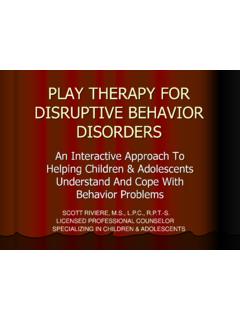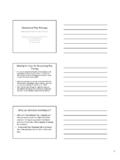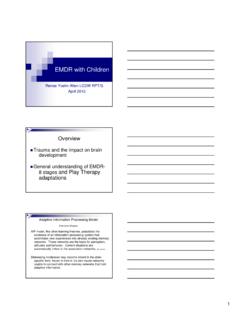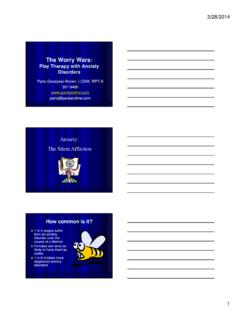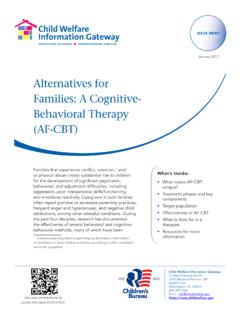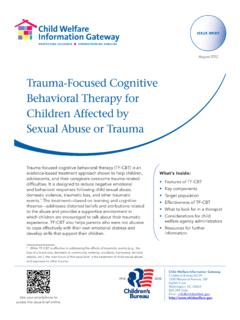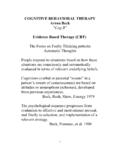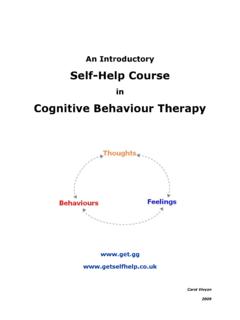Transcription of Cognitive Behavioral Play Therapy 2012 (1)
1 9/14/20121 Cognitive Behavioral play TherapyPlay TherapyJanine Shelby, , RPT-SAssociate Professor, UCLAD irector, Child Trauma Clinic, Harbor-UCLAWhy Learn More About CBT? Most Researched Method Powerful Results for Many Disorders Powerful Results for Many Disorders Increasingly Popular Can Be Integrated Easily With play Therapy MethodsTypical Points of Skepticism How Would Anyone Else Know What A Useful Thought Would Be For Me? How Can Children Engage in Therapies How Can Children Engage in Therapies with Such Sophisticated Cognitive Demands CBT Takes the Art Out of Therapy The Relationship Doesn t Matter In CBT 9/14/20122 Group Experiential ActivityHereIs the Point Where You Become ConvincedBecome ConvincedThat This Might Be UsefulCourse Outline What CBT Is Prior Cognitive Behavioral play Therapies Cognitive Model and CBT Theory Session Structure for Older Youth Session Structure for Older Youth Typical Child/Adolescent CBT Interventions play Therapy CBT Interventions Behavioral Therapies Involving play Interventions Specifically for Depression and Suicidality play Therapy Interventions for Depression and Suicidality9/14/20123 Cognitive - Behavioral
2 Therapy Cognitive - Behavioral Therapy (CBT): CBT is not a single Therapy , but multiple d l f llithti lmodels following a common theoretical basis Multiple treatment manuals/models exist to treat a variety of disorders/diagnoses Empirically-basedCBTs (cont.) Techniques draw from Cognitive and Behavioral theories Focus on symptom resolution in the here and now Sessions are structured and goaloriented Sessions are structured and goal-oriented Sessions focus on teaching Cognitive and Behavioral skills to manage symptoms Model originally developed with adults, downward extension to children/teensCBT play Therapies Are Not New Susan Knell 28322 Drewes Blending play Therapy with CBT (2009) play Therapists Goodyear-Brown, Kinney-Noziska, Shelby9/14/20124 Origins of CBTO rigins of CBT Theory: Beck s Cognitive model:Theory: Beck s Cognitive model.
3 Situation Thought Feeling/BehaviorSituation Thought Feeling/Behavior The situation itself doesn t directly determine how one The situation itself doesn t directly determine how one feels emotions/behaviors are determined by thefeels emotions/behaviors are determined by thefeels, emotions/behaviors are determined by the feels, emotions/behaviors are determined by the INTERPERTATION of the situationINTERPERTATION of the situation Scenario: You are walking down the street and see a Scenario: You are walking down the street and see a friend of yours. You say Hi! He/she does not respond friend of yours. You say Hi! He/she does not respond and walks right by you. What is going through your and walks right by you. What is going through your mind?
4 Mind? Behavioral models/behaviorism also part of CBT ( , Behavioral models/behaviorism also part of CBT ( , classical and operant conditioning, teaching Behavioral classical and operant conditioning, teaching Behavioral skills, etc.)skills, etc.)Aaron T. Beck is widely Aaron T. Beck is widely considered to be the considered to be the founding father of CBTfounding father of CBT Started as an analystStarted as an analyst Started as an analystStarted as an analyst Found focusing on conscious Found focusing on conscious thoughts more productive and thoughts more productive and practicalpractical Major contribution is Major contribution is conducting research on conducting research on psychotherapy outcomepsychotherapy outcomeSITUATIONTHOUGHTSBEHAVIORSFEELING S9/14/20125 Initial Assessment: Is CBT an appropriate treatment for your client?
5 Diagnosis Is CBT the right treatment for the disorder?disorder? CBT models tend to be diagnosis-specific Use of Standardized Measures Establish Diagnosis Clearly Before Developing a Treatment planIs CBT Appropriate for Your Patient? Ability to do talk Therapy More of an issue for the C vs. the B For young children, need to incorporate play For young children, need to incorporate play methods, but can still follow same theory Environmental intervention is critical with young childrenInitial Sessions Introduction to CBT model and structure Defining problems and setting measurable goals for treatmentgoals for treatment Build rapport/therapeutic relationship This is central to CBT9/14/20126 CBT is Goal-Oriented! Choose a personal goal to discuss during presentation How Will This Goal Be Accomplished?
6 How Will This Goal Be Accomplished?CBT Has Shown Powerful Results for Youth Trauma Depression Other Anxiety Disorders and SelectiveOther Anxiety Disorders and Selective Mutism Panic OCD GAD SAD SuicidalityBTs Have Shown Strong Results for: Developmental Delay Level of Functioning ADHD symptoms Disruptive Behavior Disorders Disruptive Behavior Disorders Reduction in Child Abuse Fequency9/14/20127 Resources Friedberg and McClure (2002) Clinical Practice of Cognitive Therapy with Children and Adolescents Session CBT Session StructureStructureGeneral Session StructureGeneral Session Structure Brief update and mood check Brief update and mood check (How was your week? What has your mood been (How was your week? What has your mood been like?))
7 Like?) Bridge from previous sessionBridge from previous sessiongpgp (Do you remember what we talked about in the last (Do you remember what we talked about in the last session?)session?) Review of homeworkReview of homework Setting the agendaSetting the agenda Discussion of agenda itemsDiscussion of agenda items Assignment of new homeworkAssignment of new homework Final summary and feedbackFinal summary and feedback9/14/20128 Check-In and Mood CheckBrief Check-In Patient needs to be adequately socialized to expectations/procedures of CBT May Need Assistance Prioritizing May Need Assistance Prioritizing Q-Sort Tasks with Most-Important, Can Wait, and Not Necessary Categories Q-Sort with My Problem and Adult Problem Problems with Brief Update for Adolescents Patient gives rambling, too detailed.
8 Or unfocused account of week Therapist should jump in and encourage Therapist should jump in and encourage synthesis Point is to get a quick overview of the week to decide what to put on the agenda Too brief/no description of week Ask multiple choice questions9/14/20129 Mood Check with Mood Check with Children and AdolescentsChildren and Adolescents Mood check Mood check Teach Affective ExpressionTeach Affective Expression Use faces, pictures, movies to help identify mood Use faces, pictures, movies to help identify mood statesstates Introduce Cognitive Model in simplified wayIntroduce Cognitive Model in simplified way faces and thought bubblesfaces and thought bubbles baseball diamondbaseball diamond playful activitiesplayful activities Need to ask a lot of questions when identifying Need to ask a lot of questions when identifying problemsproblemsFeel the WorstFeeling Thermometer109876 Feel the BestFeel the Best6543210 play -Based Mood Check Techniques9/14/201210 Problems with Mood Check Patient has difficulty reporting her mood/uses vague terms ( I feel ok ) May need to coach patient on how to May need to coach patient on how to identify and label emotions first Patient doesn t want to fill out BDI, etc.
9 Socialize patient to usefulness of these formsBridge Links sessions and session content If patient doesn t remember last session Use memory jogs Use memory jogs Teach patient importance of connecting the sessionsCBT Homework9/14/201211 Increasing Homework Compliance Practice homework in session Explain and have patient explain rationale for homework Assign specific behaviors specify what behavior should occur, how frequently, when, and so forth Review how homework will be monitored Get feedback about thoughts/beliefs and practical Get feedback about thoughts/beliefs and practical obstacles that might pose barriers Get an 80% commitment to completing homework Titrate homework ( , small increments that ensure success) Use rewards Work with parents to support and not interfere with homework Patients who do homework are most likely to get better!
10 Homework Typical types of homework assigned in CBT include: Altering cognitions Trying behaviors (e g exposure Behavioral Trying behaviors ( , exposure, Behavioral activation, coping skills) Self-monitoring ( , Panic Record, Mood Monitor, DTR) Homework should be connected to treatment goals and theoretical rationale/approachSample9/14/201212 Homework for Young Children Usually involves caregivers Should be a game or play -based activity Can be playing about a targeted situation Can be playing about a targeted situation Should be an experiential activity Behavioral experiment ExposureMake sure to review homeworkIf you don t ,it gives the message that it is unimportant and the patient won t do itCommon Difficulties with Homework Completion Doing homework at the last minute Forgetting the rationale for the homework Disorganization (help patient schedule and prioritize))
